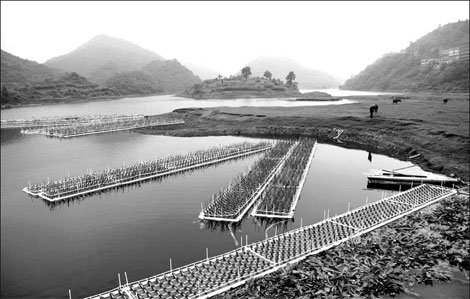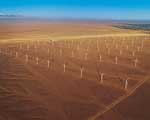China hails half decade of conservation efforts
By Zhang Zhao (China Daily)
2010-11-24 07
|
|
|
Plants are now used on a lake in Guizhou to clean pollutants and improve water quality. [Photo/China Daily] |
11th Five-Year Plan (2006-10) draws to a close with signs of progress
Building an energy-saving and eco-friendly society is a highlight of the 11th Five-Year Plan, the overall guideline of China's economic development from 2006 to 2010.
The plan set targets to reduce the nation's sulfur dioxide emissions from 25.49 million tons to 22.95 million tons over the period.
It also called for at least 70 percent of urban wastewater to be treated.
Statistics shows that the nation's energy consumption per unit of GDP last year dropped by 15.6 percent compared to 2005
Without the effort, the nation would have used 490 million more tons of coal to generate the same GDP and released 1.1 billion additional tons of carbon dioxide than it did.
The average potassium permanganate index of the nation's surface water - an indicator of water pollution - was reduced by 29.2 percent to 5.1 milligrams per liter compared to five years ago.
Sulfur dioxide emissions in China's major cities last year dropped by 24.6 percent compared with 2005.
The nation now has 540,000 square kilometers of artificial forests, the most in the world. Forested coverage expanded by more than 200,000 square kilometers from 2003 to 2008.
National leaders are paying close attention to environmental protection. A special office was established under Premier Wen Jiabao's direct leadership to guide the nation's pollution control and energy conservation efforts.
Similar offices were also established in the 31 provinces, municipalities and autonomous regions across China.
Power giants onboard
The nation's six major electricity suppliers, including China Grid, China Guodian Group and China Power Investment Corp, and more than 1,000 high energy consuming enterprises moved to reach energy conservation and emission reduction goals.
Small coal-fired power plants with a combined output of 60 million kilowatts were closed from 2006 to 2009. Outdated industrial plants were also shuttered over the same period, including factories that produced a combined 82 million tons of iron, 60 million tons of steel and 240 million tons of cement.
The central government also invested more than 200 billion yuan in key projects for energy saving and pollution control.
Daily sewage treatment capacity in urban areas grew by nearly 4.5 million tons by the end of last year to reach a total of 106 million tons.
More than 40,000 products from more than 1,600 enterprises have been approved to use for environmental labeling. About 17,000 products were added to the list in September.
A number of laws on energy consumption and pollution control were amended over the last five years while a series of new regulations and national standards were issued.
At a cost of more than 6 billion yuan, some 300 pollution control centers have been set up since 2007 to monitor nearly 13,000 enterprises
More than 500 companies had been founded by the end of last year, to offer energy conservation management and service to more than 4,000 projects.
New building materials
A variety of energy-saving and eco-friendly building materials are now promoted nationwide. Energy conservation standards were adopted in more than 90 percent of new buildings in urban areas last year.
A range of activities have been held to increase environmental awareness among the public, including an Energy Conservation Week launched in the early 1990s.
More than 1,100 youngsters from across the nation have been elected Environmental-Friendly Youth Ambassadors since last year, taking a pledge to hold awareness activities in their communities, schools or companies. More than 1 million people have been involved in the program.
With a huge market and enormous production, China is taking efforts to develop its green economy despite a late start.
As the world's largest manufacturing base for photovoltaic products, China produced 4 million kilowatts in photovoltaic batteries last year, about 40 percent of the world's total.
China also has combined wind power facilities generating 25.8 million kilowatts, the second-most worldwide, including more than 10 million kilowatts that were newly added last year.
The nation's next Five-Year Plan (2011-15) calls for further improvements in its transportation network and used of energy conserving and emission reducing technologies.
The blueprint calls for a 10 percent average reduction in vehicle fuel use by the end of 2015 compared with 2005. The target for ships is 15 percent.
Per-unit GDP carbon dioxide emissions is planned to fall by about 40 percent by the end of 2020 compared with 2005.
With the principle of "common but differentiated responsibilities", the Chinese government has vowed to continue encouraging international cooperation to cope with global climate change, encourage technological innovation and attract world-leading talent.




